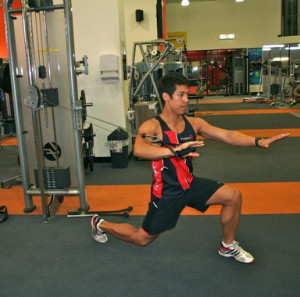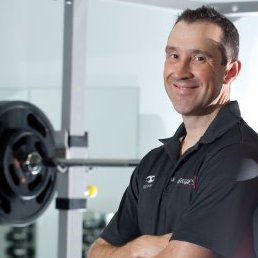Training the “Core” is one of the most popular terms used in gyms these days, and is thrown around in the sporting world as essential for preventing injury. Unfortunately many people have very poor understanding of what this really means and how to do it correctly.
Thinking of the core as just the abdominal muscles is where it all goes wrong, and this stems from a body building mindset when it comes to strength training. This has corrupted not only the fitness industry but also the rehabilitation field at times, as we get so focused on looking at the area in pain instead of how the body creates and forms patterns of complex movements in multiple sequences and chains.
All forms of isolated abdominal training which although can be good initially to activate weak inner unit core muscles such as TVA & multifidus are just that – isolated muscle training. We must start teaching people the value of learning MOVEMENT skills. In particular exercises in a standing position that require contralateral movement firing the left and right side of the brain, nervous system and preparing the body for full integration. The exercise pictured below is a perfect example of this and an exercise I use extensively with ALL clients – old, young, injured, sporting and even stroke or neurological disorder clients! The strength gains from this exercise is incredible. There has been stacks of research going right back to the pioneers of PNF, proving that strength increases in line with the development of the nervous system. Using a muscle approach is in a way making your complex computer system “dumb”.
 With the exercise pictured, the obliques and the contralateral adductors work in perfect sync to create movement. The large muscles of the chest & shoulders are pushing the cable and the muscles in the legs of the gluteal, hamstrings and quadriceps are in a static strengthening positioning to help provide stability. This movement is crucial for developing the strength and skill for walking or running. They are both important in providing that initial stability during the stance phase of gait and then contribute to pulling the leg through during the swing phase.
With the exercise pictured, the obliques and the contralateral adductors work in perfect sync to create movement. The large muscles of the chest & shoulders are pushing the cable and the muscles in the legs of the gluteal, hamstrings and quadriceps are in a static strengthening positioning to help provide stability. This movement is crucial for developing the strength and skill for walking or running. They are both important in providing that initial stability during the stance phase of gait and then contribute to pulling the leg through during the swing phase.
We must break away from a muscle approach to rehabilitation and injury prevention – which ironically is what most people think these “core exercises” are doing.
We must start teaching people the value of learning movements and that true core strength is a combination of the larger outer unit prime mover muscles working synergistically with the smaller inner unit muscles. What most people fail to understand is that the deep abdominal stabilizers are actually quite small and unable to generate force in comparison to the larger exterior muscles. They are mainly concerned with providing joint stiffness and stability over long periods of time. As we just saw the larger more powerful outer muscles are more designed to move the body but they do also play a role in providing stability via use of the myofascial slings and the nervous system’s complex motor program to sequence of movements. By training only the deep abdominals in isolated fashion will not help to improve your CORE function, if anything it will continue to cause more dysfunction as their will now be an overload on the inner unit to make up for the weakness in the more globalised outer muscles. Basically you have now taught yourself to use smaller muscles to do jobs of bigger muscles! Not a good idea if you have any type of injury. Most of these isolated exercises are performed lying down or sitting down yet most people injure themselves in a standing position. Bending over to pick something up is where most people injure their backs and then to correct it spend all this time doing ab exercises. The problem is with the movement pattern of bending. Lying on your back doing sit ups will do nothing to change the way you bend.
The purpose of injury prevention or going to a gym is to teach your body how to become smarter and rise to a new level of movement incorporating various abilities such as strength, balance, co-ordination and agility. I like to think of this like an upgrade on your computer. If you are not injured you are trying to get the latest app to download and get every bit of potential out of your body. If you are injured your computer has a virus and needs to be repaired and re-installed with the latest software. The goal is to “relearn” how to move correctly again without pain, compensation or limitation. Movements like the one showed earlier in this article will teach your body how to install these updates and make positive changes to how you move in life whether that is for sport, work or simply just moving in the home.
I hope this article helps to shed some light on what is becoming a cause of injury as opposed to what Core Strength Training is intended to be – injury prevention.
 Nick Jack is owner of No Regrets Personal Training a Rehabilitation & Sports Training Studio located in Melbourne Australia. Having worked as a Trainer for over 10 years and has qualifications as a CHEK Exercise Coach, CHEK Golf Performance Specialist & Twist Conditioning Sports Conditioning coach he specializes in working with rehabilitation and injury prevention programs. You can check out his website at www.noregretspt.com.au
Nick Jack is owner of No Regrets Personal Training a Rehabilitation & Sports Training Studio located in Melbourne Australia. Having worked as a Trainer for over 10 years and has qualifications as a CHEK Exercise Coach, CHEK Golf Performance Specialist & Twist Conditioning Sports Conditioning coach he specializes in working with rehabilitation and injury prevention programs. You can check out his website at www.noregretspt.com.au
